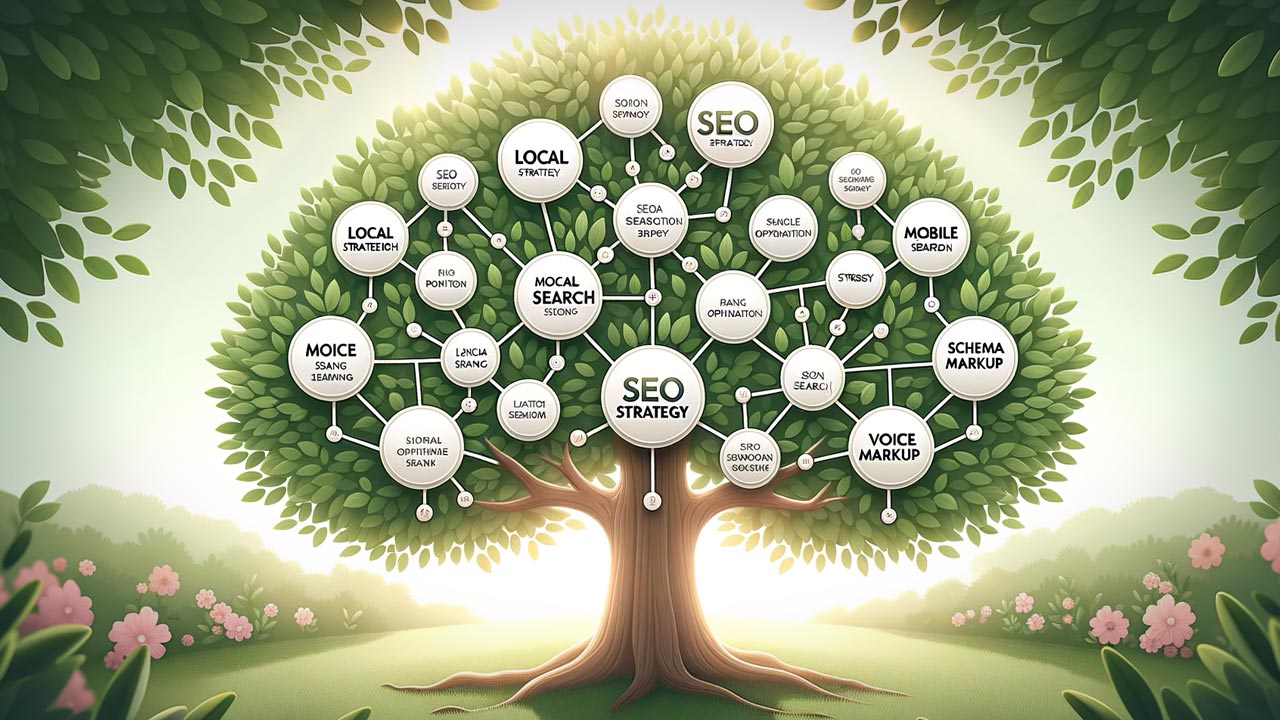SEO Topical Maps, Tips and best Practices to Implement them Effectively:
Topical Maps are a bit like piecing together a grand puzzle where each piece connects to form a bigger picture?
Here’s 20 Tips to chew on:
- User-Centric Design
Ever walked into a room and felt it was tailored just for you? That’s how users should feel about your topical map. It’s not about what you want to present; it’s about what they want to see. Put yourself in their shoes. Ask yourself, “If I were a user, what would I want?” Create a user journey that’s intuitive and satisfying. Remember, when users feel catered to, they linger. And isn’t that what we all want? - Keyword Research
Imagine you’re a detective, hunting for clues to solve the big mystery: what are people searching for? That’s keyword research for you. Dive deep into tools like SEMrush or Ahrefs. Understand the intent behind searches, not just the words. When you know what your audience is hungry for, you can serve up the exact dish they crave. - Internal Linking
Think of internal linking like holding someone’s hand, guiding them from one topic to another. Done right, it not only aids in navigation but also boosts your SEO prowess. The strategy? Don’t just link for the sake of it. Link relevant topics, create a web of knowledge that users can delve deep into. - Content Depth
Would you trust a doctor who just skimmed their medical books? Probably not. In the same vein, superficial content won’t win your audience’s trust. Dive deep. Cover facets of your topic that others might overlook. It’s about painting a full picture, not just a sketch. - Update Regularly
Remember visiting that favorite cafe only to find out they haven’t updated their menu in years? Stale, isn’t it? Content is no different. Trends change, information evolves. Keep your content fresh and up-to-date. It’s like adding new flavors to your menu, enticing visitors to come back for more. - Avoid Content Duplication
Have you ever heard the same story from a friend, again and again? It gets boring. Duplicate content on your site feels the same for search engines and users. Ensure originality. Not only does it keep things fresh, but it also avoids SEO penalties. - Schema Markup
Ever used a highlighter to mark important points in a book? Schema markup is a bit like that for search engines. It helps them understand the context of your content. Use it wisely, and you might just see your content get those coveted rich snippets on SERPs. - Mobile Optimization
Imagine trying to read a broadsheet newspaper on a crowded train. Frustrating, isn’t it? That’s how users feel when your site isn’t optimized for mobile. With a majority of users accessing content via mobile, ensure your design is responsive, making it a breeze to navigate, no matter the device. - Page Load Speed
Ever stood in a long queue, waiting for your turn? Tedious, right? Slow-loading pages are the digital equivalent of that queue. Optimize images, leverage browser caching, and streamline code. Remember, a waiting user is often a lost user. - Feedback Loop
Wouldn’t it be lovely if everything came with a feedback option, like those little buttons in elevators? Adopt that for your topical map. Encourage users to provide feedback. It’s like getting a roadmap to what works and what needs tweaking. - Voice Search Optimization
“Hey, Siri! How do I…” is more common now than you think. Voice search is on the rise, and optimizing for it is no longer an option, but a necessity. Ensure your content answers questions directly and simply, making it easier for voice search algorithms to pick up and relay your content as the answer. - Visual Elements & Infographics
A picture speaks a thousand words, and sometimes, it can convey a concept faster than text. Using visual elements like charts, images, and infographics can break content monotony and provide a quicker understanding of complex topics. - Content Personalization
Remember when you felt special because someone remembered your coffee order? That’s the feeling users get with content personalization. Using tools and plugins, present content that resonates with the user’s past behavior or preferences, making them feel seen and valued. - Multimedia Integration
Videos, podcasts, and animations can elevate your content quality. It’s a multimedia world out there, and integrating various formats can cater to diverse audience preferences, ensuring wider reach and engagement. - Accessibility
Inclusivity should be at the forefront of digital strategy. Ensure your content is accessible to everyone, including those with disabilities. This means alt texts for images, captions for videos, and easy readability for all. - Social Sharing and Amplification
Make it easy for readers to share your content. Integrate social share buttons, craft tweetable quotes, and encourage sharing at the end of your articles. When your content is good, readers become your best promoters. - User Experience (UX) & User Interface (UI) Design
An intricate topical map can fall flat if the UX/UI isn’t intuitive. Ensure smooth navigation, clear hierarchies, and logical content flow. The easier it is for a user to move through your content, the longer they stay. - CTA (Call to Action) Integration
What’s the next step you want your readers to take after consuming your content? Maybe it’s reading another related article, signing up for a newsletter, or sharing their thoughts. Clear and compelling CTAs guide your readers on this journey. - Analytics and Metrics Monitoring
Numbers don’t lie. Keep an eye on your analytics. Which topics are getting the most engagement? Where are users dropping off? Using tools like Google Analytics can provide insights, allowing you to tweak and optimize your content strategy. - Community Building & Engagement
Turn your readers into a community. Encourage comments, start discussions, and maybe even create forums or groups. When readers feel they belong, they return and become ardent promoters of your content.
Creating effective SEO Topical Maps isn’t just about compiling information. It’s about weaving a tapestry that’s rich, detailed, and user-centric. Remember, while SEO is essential, always prioritize delivering quality, valuable content to your readers. Over time, this will foster trust and authority, which are both crucial for search engine ranking and business success.
And here are five SEO Topical Maps best practices:
- Holistic Topic Coverage:
- Rationale: Search engines aim to deliver comprehensive content that fully satisfies user queries.
- Practice: Identify the primary topics and their relevant subtopics in your niche. Ensure you cover each topic in depth, leaving no gaps in information. Imagine constructing a complete web where each piece of content fills a specific need.
- User Intent Alignment:
- Rationale: SEO is not just about attracting clicks but ensuring user satisfaction post-click.
- Practice: For every topic or subtopic, determine the user’s potential intent – informational, transactional, navigational, or commercial. Create content that aligns with and fulfills this intent.
- Internal Linking Structure:
- Rationale: Properly interlinked content can guide users through their journey, reduce bounce rates, and distribute page authority throughout your site.
- Practice: Whenever you create a new piece of content, link to related articles or pages within your website. This provides a roadmap for users to follow and boosts the SEO value of interconnected pages.
- Regular Content Audits and Updates:
- Rationale: The digital landscape is always evolving. What was relevant and accurate yesterday might not be today.
- Practice: Periodically review your topical map and the content that stems from it. Update outdated information, remove redundant articles, and add fresh content to address emerging topics. This keeps your content relevant and authoritative.
- Integration with Keyword Strategy:
- Rationale: While a topical map focuses on broad topics, integrating specific keywords ensures you’re tapping into precise search queries.
- Practice: For every topic and subtopic in your map, conduct keyword research. Identify primary and secondary keywords, long-tail phrases, and related queries. Infuse these keywords naturally into your content, ensuring it’s optimized for both broad topic relevance and specific search queries.
Implementing these best practices ensures that your topical map not only serves as a foundational blueprint for content creation but also as a strategic tool for effective SEO.
Further reading:
Google offers a lot of resources for website owners, content creators, and SEO professionals. One of the best comprehensive and authoritative resources is Google Search Central (previously known as Google Webmasters).
- Overview: This is a hub for all resources and tools related to Google Search. It offers guidelines, documentation, and tools to help you optimize your website for search.
- Highlights:
- Search Console: A free tool that lets you monitor, maintain, and troubleshoot your site’s presence in Google Search results.
- Search Central Blog: Here, Google updates users about new features, algorithms, and best practices related to search.
- Community Forum: Engage with other webmasters and get your questions answered.
- Learning & Documentation: Detailed guidelines on topics like structured data, AMP, and other search-related subjects.
- Why it’s valuable: Google Search Central provides direct insights from Google. Following its guidelines and leveraging the tools it provides can be instrumental in achieving and maintaining good search performance.
- Link: Google Search Central
For those of you diving deep into SEO Topical Maps and content strategies, it’s a good idea to familiarize yourself with Google Search Central. It offers a direct line to understanding how Google views search optimization and provides invaluable tools to help websites perform better in search results.











Leave A Comment